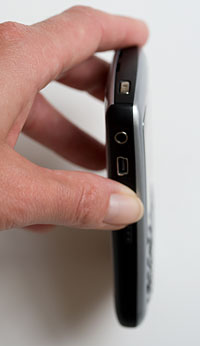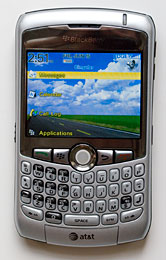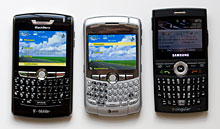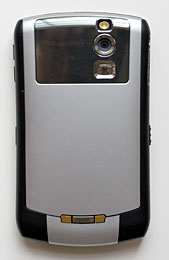
|
||||||||||||

Phone Features, Data and Reception The BlackBerry 8300 is a quad band 850/900/1800/1900 MHz GSM phone that works anywhere in the world GSM service is available. It's sold locked to AT&T, which means you must use an AT&T SIM in the phone (customers in good standing can generally call customer service for an unlock code if traveling overseas). The BlackBerry has EDGE for data but unfortunately no 3G. Since CDMA BlackBerries have had EVDO for some time, we're surprised that there's still no 3G GSM version for AT&T whose high speed network is well-deployed in metro areas. Thus overall, don't expect any significant speed improvements for web page, email and attachment download over previous EDGE BlackBerry phones. That said, RIM has always done a good job of making email download a fast process and we can't say it takes any longer than downloading email on the 3G (HSDPA) Samsung BlackJack-- in fact it's a bit faster. Full HTML web pages do take longer to download on the Curve than on the BlackJack, but speed is quite good, even when the browser is set to desktop mode and IE emulation. The BlackBerry still doesn't render HTML email (you'll see some ugly text in HTML-only emails) but a beta 3rd party plugin called Empower shows good promise for making those HTML emails pretty and more readable. Like all BlackBerry phones, the Curve handles push email via BIS (BlackBerry Internet Server) provided by your carrier and BES for those whose companies run BlackBerry Enterprise Servers. BIS users can set up a dedicated BlackBerry email address (janedoe@mycingular.blackberry.net) which you'll manage on Cingular's BlackBerry settings web page, and you can setup POP3 and IMAP accounts from personal and non-BlackBerry server work email accounts. Enterprise users can manage (or have their IT folks manage) their accounts as per usual. In addition, RIM offers their desktop redirector software, a Windows-based application that redirects mail from your PC's inbox to your BlackBerry. The BlackBerry web browser has grown up and is no longer put to shame by Windows Mobile, Nokia S60 and even Palm OS' Blazer web browser. The browser supports both WAP and HTML sites, and offers both single-column and desktop views. Similar to Nokia's S60 web browser, and Thunderkawk it has a full-page overview in thumbnail format and you can position your cursor to choose only the part of the page you wish to see. The browser also supports tables, some Javascript, history, bookmarks, CSS and more, though you may need to turn these features on using browser options. If your BlackBerry Enterprise Server is v4.1 or greater, you can use the web browser to open attachment files in Word, Excel, PDF and more. Call quality is good and volume is loud by GSM standards. The speakerphone is clear and loud. The Curve has good but not stellar reception, with a signal that's short of the Treo 750 and Samsung BlackJack on EDGE. The Curve generally runs a bar less of signal compared to these two, which still makes for good reception but not the best if you frequent marginal coverage areas. Horsepower and Performance The BlackBerry Curve runs on a 312MHz Intel XScale processor. That's the same CPU used in the 8800 and faster than the BlackBerry 8830's CPU. As with most Berries, the Curve is responsive and performs most tasks with good speed. The BlackBerry 8300 has 32 megs of RAM (used like RAM in your computer) and 64MB of flash memory for storage. Before loading data and applications, the Curve has 21.8 megs of free storage. When you first setup the phone, it will ask you if you wish to delete languages other than English, and after doing so we had 21.8 megs of free memory. To expand the storage space for data (but not application installation), the BlackBerry comes with an SDHC microSD card slot and you can use up to 4 GB cards to store your data (more when higher capacity cards become available). The card is located under the battery unfortunately, which means you must power down the phone to insert or remove a card. Display and Multimedia Like the BlackBerry 8800 series of smartphones. the Curve has a QVGA (320 x 240) TFT display that’s very bright, colorful and crisp. It has a light sensor that adjusts to ambient lighting conditions, and you can turn this feature off -- though we found it worked well except in near-dark rooms where the display sensor opted for too little backlight. The screen is capable of displaying 65k colors and is extremely bright at 100%; too bright for AT&T's washed out theme (RIM's Dimension theme is pre-installed as well and we opted for it and its more familiar icon set). The screen is viewable outdoors, more so than Windows Mobile Professional (Pocket PC) and the Palm OS Treo PDA phones. The Media Player application has been jazzed up with a skin compared to the 8800's dull media player. There are 4 icons for music, video, ringtone and photos viewing/listening. The music player has options for shuffle, genres, play by artist and play by album. The image viewer is fairly fast and you can use it to set any image as the home screen background. the ringtone manager at The media player plays MP3, AAC/AAC+/eAAC+ and WMA files. You can use the microSD card to store music and video. Sound is decent through the mono speaker and very good with the included 3.5mm stereo headset with inline mic.
The Media Player can also play video in MP4, H.263 and Simple Profile WMV formats. Video playback is smooth and sound is in sync with video even at QVGA resolution, just make sure you've encoded the file in a compatible format. The BlackBerry desktop software can help convert both audio and video files to the formats that the device can play.
Bluetooth We tested the BlackBerry Curve with several Bluetooth headsets and it paired with all easily. The Jawbone Bluetooth headset performed best among all headsets we tested with the Curve. Voice was clear and full, and volume was plenty loud. The Jawbone's noise canceling feature works very well with the 8300 and it canceled-out almost all ambient noise in both mildly noisy and very noisy conditions (it silenced a jet plane flying fairly low overhead without muffling the speaker's voice). The range was quite good, and we got about 20 feet before voice quality degraded. The Plantronics Discovery 655 also had good voice quality with the BlackBerry Curve, though voice wasn't as full as with the Jawbone. Voice was clear and volume loud. The DSP worked OK on the Plantronics: we still heard some noise (unlike the Jawbone with its noise canceling turned on), but it was minimal. Range isn't the Plantronics 655's strong point, and thus we got about 5 feet at best before hearing some crackling and voice breakup. The BlackBerry 8300 is the first RIM device to offer A2DP, a feature allows you to listen to music wirelessly via a Bluetooth stereo headset. We tested the Curve with the Plantronics Pulsar 590A and the Motorola S9 stereo Bluetooth headsets, and the BlackBerry paired with both fine. The audio quality for music wasn't the best we've heard on an A2DP mobile phone, though it was certainly good. We noted less stereo separation and fullness compared to the best A2DP phones. The volume is good and range is acceptable. You can hear some noticeable white noise via the Motorola S9, but that's not the BlackBerry's fault. This headset has white background noise (hiss) on all the phones with which we've tested it. The Curve supports handsfree, headset, A2DP, AVRC, DUN (dial up networking) and file transfer. Battery Life The Curve has an 1100 mAh Lithium Ion battery that's user replaceable. It ships with RIM's standard world-friendly charger with fold-down prongs. As with most GSM BlackBerry phones, the Curve has excellent battery life (being EDGE-only helps). Push email generally greatly reduces battery life on competing smartphone platforms, but somehow RIM manages to give us phones that last 2 to 3 days on a charge. Claimed talk time is 5 hours and we got close to that. Standby is 22 days-- very long by smartphone standards. Conclusion We like recent BlackBerry smartphones, and the Curve is no exception. It does all the things you'd expect from a BlackBerry but it's smaller, cooler looking and boasts decent, though not earth-shattering multimedia capabilities. The Curve is responsive, easy to use, easy to type on and it has good quality. Though not as pretty as the BlackBerry 8800, the Curve feels better in the hand and is easier on the pocket, price-wise. For those not tied to corporate rules, the camera adds a bit of fun, though we can't say the image quality is anything to write (or more than MMS) home about. Pro: Stable, fast and easy to use. Great curvy ergonomics. Good call quality, very good music playback quality and A2DP support (something the more multimedia-oriented iPhone lacks). Battery life, as is generally true of RIM devices, is quite good. Con: Not a con, per se, but an important consideration if you're thinking of the Curve vs. the 8800 line: the Curve lacks a GPS. Still no 3G on a BlackBerry. You have to turn off the phone to insert or remove a memory card. Web sites: www.blackberry.com, wireless.att.com Price: $299 with 2 year contract
| ||||||||||||







